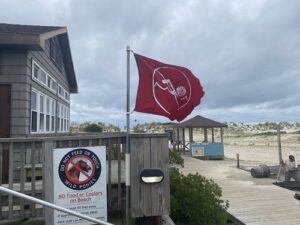
Visitors to public swimming areas should observe signage for when locations and conditions are dangerous, such as this red flag at Assateague State Park. Maryland Department of Natural Resources photo.
As we reach the height of summer, the Maryland Department of Natural Resources reminds residents and visitors to swim near a lifeguard, wear a life jacket, and to always swim and boat sober.
Drownings are more likely to occur when lifeguards are not present. In June, a man died while swimming in an unguarded section of Patapsco Valley State Park, in the park’s McKeldin Area, the same location as a death that occurred in 2023.
Visitors should always look for signage that informs whether an area is unguarded, is off limits to swimming, or if there are unsafe conditions for swimming.
Ideally, people should always swim in a guarded area. The Maryland Park Service operates guarded beaches for most of the summer season at Assateague Island State Park, New Germany State Park, Deep Creek Lake State Park, Greenbrier State Park, Herrington Manor State Park, Rocky Gap State Park, and Sandy Point State Park. At Gunpowder Falls State Park, guards are available every day except Monday, and at Point Lookout State Park guards are available on the weekends. Dans Mountain State Park has a guarded pool. The pool at Pocomoke State Park is closed for the 2024 season due to renovations.
These swimming spots are popular and can fill to capacity on holidays and weekends – visitors should call ahead or check Maryland Park Service social media for closure information and to make sure lifeguards are on duty that day. As with many seasonal operations, the parks have issues with staff shortages, especially late in the season when students return to school. DNR is recruiting lifeguards for this summer on the Maryland state jobs website.
For parents and guardians of young children, it’s important to remember that a lifeguard is not a babysitter – children should be watched at all times around the water.
Open water poses more hazards than swimming in a pool – currents, sudden changes in depth, poor visibility underwater, and temperature changes. Jellyfish are also a hazard at some swimming beaches on the Atlantic Ocean and the Chesapeake Bay.
Regardless of locations, some rules swimmers should always follow are:
- Never swim alone.
- Be careful when walking on wet or slippery rocks near the water.
- Do not swim if you are drunk or high.
If a swimmer is in distress, those nearby should remember: “Reach. Throw. Do Not Go.” Call for help and reach out to the individual with a long item, or throw them something that floats. Do not jump in.
When swimming in open water, it is extremely difficult to swim with currents, tides, and waves without becoming exhausted. The water may be murky, concealing objects and hazards below the surface. Do not dive into the water head first.
Wearing a life jacket is another great way to promote the safety of your family when swimming or boating.
Visitors can also borrow a life jacket. Maryland Natural Resources Police operates a Life Jacket Loaner station at Sandy Point State Park. The SeaTow Foundation and the Boat U.S. Foundation have life jacket loaner programs with locations throughout the state.
When boating, everyone on board must have a life jacket that fits them – if life jackets are not being worn, they must be easily accessible. Children younger than 13 must wear a life jacket if the boat is 21 feet or less and the vessel is not at anchor, docked or they are in a cabin. Maryland Natural Resources Police patrol the waterways enforcing this law.
It is also essential to wear a “kill switch” when piloting a power boat, which clips to the skipper’s clothing or life jacket, and automatically stops the engine when pulled. If a skipper goes overboard, a kill switch can help prevent cuts, injuries and death from propeller blades.
All boaters should file a “float plan” with family or friends before leaving the dock, providing as much information as possible: When are you leaving? What time do you plan to return? Who is going with you? Where are you going?
More information about boating safety is available on the DNR website.


